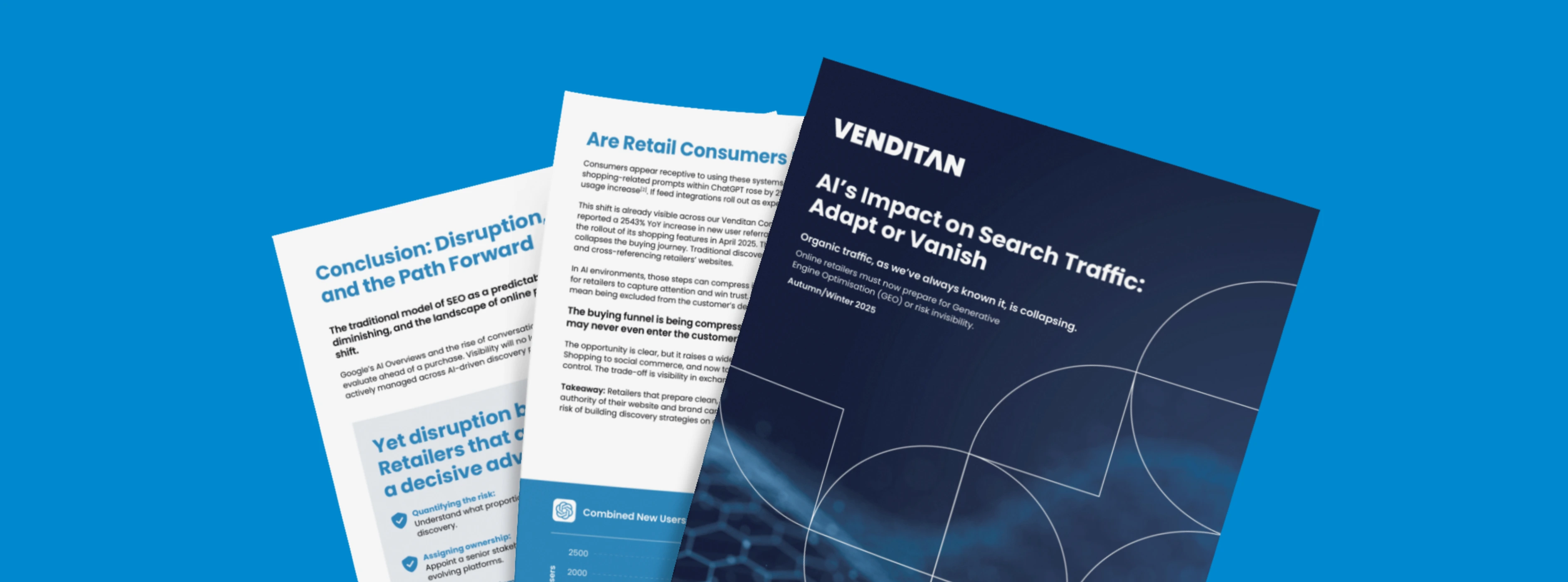“Mobile is fast becoming the most important part of eCommerce and the omnichannel experience. To remain competitive, retailers need to do more than just keep up with the status quo. Our short survey has done well in highlighting some of the issues surrounding this. The insightful report ahead is perfect for retailers and eCommerce businesses who haven’t yet made mobile their core focus, and those who are weighing up their options.”
John Coyne, Director, Venditan
Quick links:
.01 Introduction
.02 Why is it important to offer the best mobile experience?
.03 Improving your mobile eCommerce offering
1. Introduction
We recently set out to look at what retailers and eCommerce professionals think of mobile eCommerce. We’ve found a very varied landscape, where the businesses adapting to the popularity of mCommerce are reaping the rewards, whereas those who haven’t yet invested in this area are inevitably missing out on a growing segment of the customer base. The following report is a deeper look into the state of mobile commerce, the importance of mobile experience in eCommerce and how retailers can take the next steps and make the most of the exciting opportunities that mobile commerce is presenting. Hopefully, this report will be a useful tool for retailers wanting to improve their mobile offering and start giving their customers the best mobile experience possible.
What is mobile commerce?
Defining mobile commerce: Mobile commerce, or mCommerce, refers to the purchasing or selling of products and services via devices like mobile phones or tablets.
Mobile commerce was first made possible in 1997 when a Coca Cola vending machine that could accept payments made by SMS text message was installed in Helsinki, Finland. It’s come a long way since then. The past 23 years have seen rapid evolution and wide adoption of mobile commerce and digital payments for all manner of goods and services.
Assessing the current situation
During our investigations, we’ve identified that there are still a number of retailers who need to improve their mobile experience for customers. In today’s increasingly mobile world, these retailers are missing out on a growing segment of shoppers and a large chunk of potential sales.
It’s more important than ever before to keep up with the trends in mobile commerce. More and more people are using their mobile phones to shop. A report by BrizFeel finds that 49% of people shop on their mobile phones. That’s an incredibly high amount, which is only set to grow as preferences for convenience increase and mobile technology improves.
So, for eCommerce businesses, now is the time to invest in improving their mobile experience offering to customers.
We surveyed a collection of retailers and eCommerce professionals who currently do not have a mobile commerce presence, such as a mobile-responsive site. Our aim with the report is to get an idea of the current issues surrounding mobile experience from retailers who haven’t yet invested in it. We want to create an interesting view of the mobile commerce market in order to inform retailers who are wanting to improve the mobile shopping experience for their customers.
Key findings from our survey:
- 67% of retailers surveyed believe mobile commerce is important
- 15% of businesses surveyed are planning to improve their mobile commerce offering in the next 12 months
- The number one factor holding businesses back is cost
2. Why is it important to offer the best mobile experience?

Shopping on mobile is extremely popular
As more people than ever before are shopping on their mobiles, retailers need to keep up with this rapidly growing consumer habit or end up falling behind. The numbers show that mobile is well on it’s way to becoming consumers prefered method of online shopping. A report by CBRE predicts that over half of all eCommerce sales will be carried out on mobile by 2021.
Mobile-first SEO
Google’s algorithm prioritises mobile sites and now ranks websites mobile-first. Googlebot crawls and indexes your web pages based on how they render on a mobile. So, if your mobile web pages aren’t up to standard, you won’t rank highly. By not having a great mobile site, you risk falling down the ranks in search engine results and losing out to competitors who are paying attention to their mobile offering.
Better customer experience
Not only does a brilliant mobile website affect your SEO, but also puts the customer first, and appeals to a wider audience. A better performing mobile site will enhance the customer experience and lead to more conversions. According to Google, 62% of shoppers are less likely to buy from a brand in the future following a negative mobile experience.
For example, the rendering of a desktop site on a small mobile screen can reflect poorly on a brand and damage trust and credibility.
Supports omnichannel eCommerce
You may not think it, but good mobile website design is pivotal to shaping great in-store experiences. Mobile supports the in-store buying journey and by having better mobile accessibility with a mobile-responsive website, or an app, will positively impact your store sales.
The popularity of mobile payments
Mobile payments are extremely popular methods for consumers right now. Payment methods like Apple Pay and Google Pay are really convenient ways to pay for goods, with just a tap of a smartphone. Mobile websites and apps easily adapt to the needs of the customer. They help facilitate faster and fashionable mobile payment methods. With digital payments like these, many users feel safer prompting payments using just their fingerprints rather than inputting their card details.
The FinTech industry is currently booming and certainly making waves in the mobile eCommerce industry with it. Retailers need to take notice of this trend and start including mobile payments as a part of their eCommerce offering to keep up with this exciting landscape.
Read more: eCommerce payment solutions
The power of social media
When it comes to mobile experiences, it’s also important to remember the popularity, and power, of social media and eCommerce. Lyfemarketing reveals that 91% of social media users access their platforms via a mobile device, with 80% of the time spent on social media being via a mobile phone.
Many people use social media platforms to research product reviews and recommendations, with GlobalWebIndex finding that 54% of people use social media to do so. This means there’s a huge opportunity for retailers to align their social media marketing with mobile landing pages as a part of their campaigns. If a mobile user browsing on social media clicks on a product and lands on a non-responsive website or a low performing mobile website, the likelihood is they’ll drop off and shop elsewhere.
Social media platforms like Pinterest, Instagram and Facebook also act as marketplaces where you can sell directly to the customer via these channels. For shoppers looking to buy products this way, they’ll also be expecting the same level of service should they click through on a mobile device to your website.
It’s also important to recognise that most people using social media do so via an app for the platform. Switching between apps on mobile is more commonplace than using mobile search engines and browsers. Retail apps are growing in popularity partly due to this shift in mobile user habits, so it’s really important for ambitious retailers wanting to make app commerce a part of their strategy.
Faster mobile browsing
When a user clicks through to your site on a mobile device and a desktop website loads, it will inevitably take a lot longer to respond than one optimised for mobile. Just think of all the elements that will need to load! Time is money when it comes to eCommerce and potential customers will abandon your site if it doesn’t load quick enough, in fact, Google has found that if a mobile web page takes longer than 3 seconds to load, 53% of users will leave that page.
A well designed mobile site will adapt automatically to the device the user is accessing your site on. This means images, content and all the other elements that make up the landing page will load a lot faster, preventing a high bounce rate and lost sales.
3. Improving your mobile eCommerce offering

Websites
Optimising your website for mobile is incredibly important for eCommerce businesses, as you can see from the above points. There’s a lot to think about when it comes to improving your mobile website. Having a mobile-responsive website today is a really fundamental and basic part of online trading. A website that is optimised for mobile will automatically adjust the size to fit different screen types, depending on what device it’s being accessed on. A website that is not responsive will not render correctly across all devices, interrupting the user experience. This is especially detrimental for eCommerce businesses as this disruption can lead to higher bounce rates and lower conversions.
Our survey found that 48% of businesses surveyed actively track mobile users on their site, with almost an even split at 42% not tracking this, and 10% unsure. Of those who do actively track mobile users, they found that on average, between 30-40% of their website visits are coming from mobile devices. These are large segments of the businesses’ customer base that aren’t getting the better experience that they could be if the sites were optimised for mobile.

When considering how your mobile website will look, you will need to reshape your content offering and eliminate unnecessary wording. When writing and reducing content for a mobile screen, you need to ask yourself – what part of my message is most important? What content will support the buyer journey and give a better mobile experience? Prioritising your website content in this way means you’ll be able to deliver the simplest and most effective message across your website.
This also works for the design elements too. You’ll be able to create a more practical and functional website by eliminating elements that don’t translate as well from desktop to mobile. Things like flash, large images, menu and navigation functions that can result in aesthetically poor and hard to use websites.
Mobile SEO
It’s incredibly important for your eCommerce site to be mobile optimised and ready for Google’s mobile-first indexing. Things you can focus on when assessing and improving your mobile SEO are things like page load times – the faster the better. Focus on content for page titles and meta descriptions – with less space on mobile screens, keep these short, sweet and to the point. Consider Local Search for stores if you’re a store wanting to be discovered by locals. Using Local Search is a great way to get found as a lot of people use search terms like ‘shops near me’ when out shopping.

Our survey reveals that 19% of retailers have found they’ve been affected by Google’s mobile-first indexing, with a large 52% unsure (graph below). For eCommerce businesses, it’s all about keeping up with consumer demand and buying habits, which are increasingly digital. 59% of retailers who took part in our survey said that their main competitors already have mobile-responsive websites, with 29% unsure. By not having a mobile-responsive website in eCommerce, you run the real risk of being overtaken on Google by your competitor’s mobile-responsive websites.

Apps
It’s a really exciting time to be venturing into the world of app commerce. Mobile shoppers are increasingly favouring apps, so much so that 78% of people responded to a recent survey by Code Brew stating they prefer shopping on apps than mobile websites. It’s also been found that users spent 18 billion hours on shopping apps in 2018.
With an eCommerce app, you’re furthering your mobile offering and undoubtedly have a greater advantage in taking the mobile shopping experience to new heights for your customers. With increasing numbers of app users and the advances in technology, retail and eCommerce businesses using apps are seeing increasing revenues.
Let’s take a look at some of the benefits of having an eCommerce app:
Faster than a browser - Apps work faster than browsers because there is more data already stored in the app, meaning less processing for servers so users get a faster and better experience.
Personalised experience - People are craving more personalised experiences and in such a competitive industry, apps help you deliver on this and stand out. 61% of mobile consumers say they’re more likely to buy from mobile sites and apps giving more personalised offers and experiences.
Supports in-store experience - Apps play a large part in the in-store shopping experience and having a super-fast app will positively impact your store sales. 80% of in-store shoppers use their phones for browsing products while in-store, so supporting this you increase the opportunity for sales.
Brand visibility - With an on-brand, fully tailored app, your branding is always going to be visible on your customer’s phone. We use our phones so much in our day to day lives so this level of exposure is brilliant for keeping you at the forefront of your customer’s minds.
Convenient checkouts - Apps allow much faster checkout processes through integration with Apple Pay and Google Pay. With a secure login, customers can save cards to their account for fast payments and one-click checkouts.
Use device features - Use phone features like location to auto-populate click and collect address and local in-store offers. With camera and microphone access you can offer image and voice search capabilities.
Push notifications - Use push notifications to keep your customers up to date with delivery progress, letting them feel in control of the process. You can also use push notifications to support marketing, increasing conversions and boosting sales.
Customer service - Support your customers with in-app live chat. It’s a really effective form of customer service, saving your time and resources on dealing with other forms of inbound queries. With only 6% of retailers offering this at the moment according to research, there is a large gap in the market that clever retailers can take the opportunity to fill. If live chat isn’t for you, consider features like one-click calling and Google map integration for finding your stores.
In-store
Mobile experiences for in-store customers are an important part of your omnichannel eCommerce strategy and its key to know just how mobile commerce supports these in-store buying experiences. So, for those of you thinking mobile isn’t relevant because you primarily focus on bricks and mortar offering, think again.
A study by Power Review shows that 80% of in-store shoppers are using their mobile phones to search for products while browsing. They also use mobile devices to look at product reviews and compare pricing whilst in stores. By creating a seamless, omnichannel experience for these in-store customers, you will increase the opportunity for conversion.
In order to support the in-store experience with mobile optimisation, you will want to consider things like targeting customers through proximity marketing and sending out push notifications and offers when they are near to stores. Add a loyalty card function in your app too so that points can be gained on instore purchases for members. Ensure your point of sale integrates with contactless payments, facilitating mobile payments like Apple Pay and Google Pay.
Consider using things like barcode search or QR codes on in-store products so they can easily be scanned for customers to find out more product information online before buying, or save items to an online wishlist for purchasing at a later date.
Obstacles: what’s holding retailers back?
It’s one thing for us to talk about the benefits of improving the mobile experience, but we wanted to find out the real reasons as to what is holding back the retailers who haven’t made this move. With 23% of respondents have had to deal with complaints from customers, it’s clear that not offering great mobile experiences today is causing disjointed customer experiences. This can be detrimental to brand positioning and trust.
Interestingly, 67% of retailers surveyed, who don’t currently have a mobile optimised website, believe that having a mobile site is important, but there are certain factors stopping them from making the changes, with worries about costs and resources coming out on top.
4. The opportunity for retailers

Adapting your eCommerce offering to mobile offers its own set of challenges, yet there is an enormous opportunity for retailers going forward into mobile commerce. Success lies in being ahead of the curve when it comes to mobile commerce, and you need a strong mobile offering today to remain competitive.
It’s clear there is a vast gap that needs filling when it comes to the standards of mobile vs desktop experience. Many eCommerce sites are simply not getting it right. However, those who are looking to adapt and embrace mobile are inevitably going to reap the rewards for doing so.
We asked our survey respondents whether they are planning to improve their mobile commerce offering in the next 12 months. Surprisingly, as few as 15% are definitely looking do make this move, with 56% saying this is not yet on their radar. 29% are still on the fence as to whether this is on the cards for their business. This shows that for the ones who are looking to improve their mobile eCommerce, there is a huge opportunity for them to do so as others are lagging behind.

5. Taking the next steps

So, do you think it’s time to expand and improve your mobile commerce? There are a few things you may want to think about before getting started. Firstly, you might want to check your own mobile usability to then best focus on what needs improving. First things first, you can get a Mobile Usability Report from Google.
From here, there’s a load of things you can do to boost your mobile commerce offering and make sure you’re giving your customers the best possible mobile experience.
Set goals
Every business will have different goals for their mobile commerce, so you need to consider the ones specific to your company. These could be a number of things, like improving customer experience, strengthening your brand, increasing sales and conversions. Use these to guide your objectives and overall strategy, considering time, budget and resources needed to achieve them.
Do your research
Take a look at not only your competitors but any mobile sites and apps out there that catch your eye. What are they doing right, and what are they getting wrong? Get a feel for what others are doing and what opportunities there are for your business. Pay attention to navigation and usability.
Put your plan into action
Having settled on your goals and done your research, you’ll have a decent idea in mind of what you want your approach to mobile commerce to be like. It’s a highly technical job, so do your research on who you want to help you undertake this task, and how you want it done. Are you wanting to hire in-house (which can be costly!) or, do you want to outsource? With a good plan in place, you can now reach out and get an idea of costs, timescales and the finer technical details you’ll need to consider like integrations and software.
Final thoughts
There’s no escaping the growing popularity of mobile commerce, and the need for retailers to adapt to these trends. If you’re not offering the best possible mobile shopping experience for your customers, they will inevitably shop elsewhere. You’ll lose customers by putting too many obstacles in their way of making a purchase with you, the process needs to be as simple as possible, super easy, and convenient.
There are so many reasons why you should make the move to mobile commerce. It opens up the door to a wider audience base, strengthens your brand, and ensures you’re keeping up with your competitors. Ultimately, leading to an increase in conversions and sales.
In the future, we’re not only going to see the number of mobile shoppers grow even more, but a change in the way retailers and eCommerce businesses deal with these customers. Technological advancement and consumer habits will lead to a mobile-centric approach to UX, website development and marketing.
Our team has worked with 100s of retailers, creating state of the art eCommerce websites for both desktop and mobile. Discuss your next project with us.
Our recent posts
Keep up to date with the latest news and insight from the team at Venditan





.webp)



.webp)
%20(1).webp)


